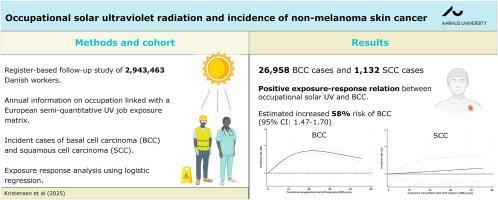Occupational solar ultraviolet radiation and incidence of non-melanoma skin cancer in a nationwide cohort
IF 7.3
2区 环境科学与生态学
Q1 ENVIRONMENTAL SCIENCES
引用次数: 0
Abstract
Non-melanoma skin cancer (NMSC) is the most common cancer worldwide. Solar ultraviolet radiation (UVR) is the primary risk factor. Consequently, outdoor workers face a potential long-term occupational hazard, but little is known about the extent to which occupational UVR exposure affects the risk of NMSC. We aimed to quantify the exposure-response relation between occupational solar UVR exposure and NMSC incidence in a nationwide cohort. We conducted a register-based cohort study of the entire Danish workforce 1977–2015 assessing the association between occupational UVR exposure and the incidence of basal cell carcinoma (BCC) and squamous cell carcinoma (SCC) as recorded in the Danish Cancer Register. Exposure was measured in standardised erythema dose (SED) based on a newly developed European UVR job exposure matrix. We analysed confounder-adjusted incidence rate ratios of NMSC with a discrete-time hazard model and modelled the shape of the exposure-response relation with restricted cubic splines. Of the 2,943,463 workers followed for a median of 20 years, 26,958 were diagnosed with BCC and 1,132 with SCC. Median cumulative exposure was 5.99 SED-years. We observed a positive exposure-response relation between occupational solar UVR and BCC, with an adjusted incidence rate ratio of 1.58 (95% CI: 1.47-1.70) in the highest exposure quartile compared with the lowest. Results for SCC suggested a similar exposure–response pattern, although not reaching statistical significance. We observed a strong exposure-response relation between occupational solar UVR exposure and the risk of NMSC in Danish workers. These findings underscore the need for implementing preventive strategies.Trial registration number
j.no.: 1-16-02-196-17.

职业性太阳紫外线辐射与非黑色素瘤皮肤癌发病率的关系
非黑色素瘤皮肤癌(NMSC)是世界上最常见的癌症。太阳紫外线辐射(UVR)是主要的危险因素。因此,户外工作者面临潜在的长期职业危害,但对于职业性紫外线照射对NMSC风险的影响程度知之甚少。我们的目的是在全国队列中量化职业性太阳紫外线照射与NMSC发病率之间的暴露-反应关系。我们对1977-2015年整个丹麦劳动力进行了一项基于登记的队列研究,评估职业紫外线辐射暴露与丹麦癌症登记处记录的基底细胞癌(BCC)和鳞状细胞癌(SCC)发病率之间的关系。根据新开发的欧洲UVR工作暴露矩阵,以标准化红斑剂量(SED)测量暴露。我们用离散时间风险模型分析了混杂因素调整后的NMSC发病率比,并用受限三次样条曲线模拟了暴露-反应关系的形状。在随访时间中位数为20年的2,943,463名工人中,26,958名被诊断为BCC, 1,132名被诊断为SCC。中位累积暴露量为5.99 sed -年。我们观察到职业性太阳紫外线辐射与BCC之间存在正的暴露-反应关系,最高暴露四分位数与最低暴露四分位数的校正发病率比为1.58 (95% CI: 1.47-1.70)。SCC的结果显示了类似的暴露-反应模式,尽管没有达到统计学意义。我们观察到职业性太阳UVR暴露与丹麦工人NMSC风险之间存在很强的暴露-反应关系。这些调查结果强调了执行预防战略的必要性。试验注册号:1-16-02-196-17。
本文章由计算机程序翻译,如有差异,请以英文原文为准。
求助全文
约1分钟内获得全文
求助全文
来源期刊

Environmental Pollution
环境科学-环境科学
CiteScore
16.00
自引率
6.70%
发文量
2082
审稿时长
2.9 months
期刊介绍:
Environmental Pollution is an international peer-reviewed journal that publishes high-quality research papers and review articles covering all aspects of environmental pollution and its impacts on ecosystems and human health.
Subject areas include, but are not limited to:
• Sources and occurrences of pollutants that are clearly defined and measured in environmental compartments, food and food-related items, and human bodies;
• Interlinks between contaminant exposure and biological, ecological, and human health effects, including those of climate change;
• Contaminants of emerging concerns (including but not limited to antibiotic resistant microorganisms or genes, microplastics/nanoplastics, electronic wastes, light, and noise) and/or their biological, ecological, or human health effects;
• Laboratory and field studies on the remediation/mitigation of environmental pollution via new techniques and with clear links to biological, ecological, or human health effects;
• Modeling of pollution processes, patterns, or trends that is of clear environmental and/or human health interest;
• New techniques that measure and examine environmental occurrences, transport, behavior, and effects of pollutants within the environment or the laboratory, provided that they can be clearly used to address problems within regional or global environmental compartments.
 求助内容:
求助内容: 应助结果提醒方式:
应助结果提醒方式:


